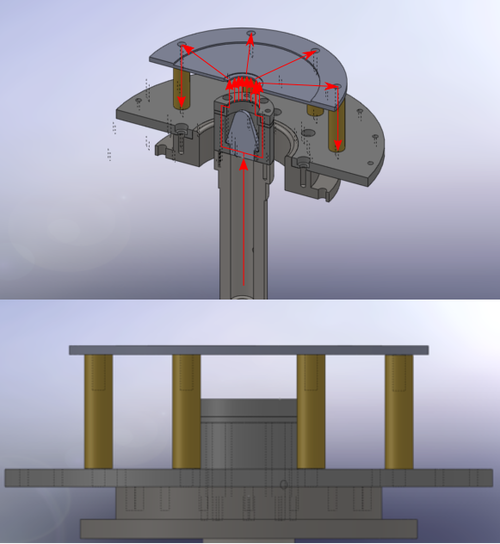This morning, at 10:30 am, I fired my first shot on MAGPIE. I wrote about the goals of this first series of experiments in an earlier post. I intend to implode a cylindrical array of fine metal wires, and use the x-rays produced to ionise a gas. This is a complicated experiment, so to start with I want to test the different bits of hardware one at a time, slowly building up the complexity.
First of all, I wanted to implode a simple wire array. The array is made up of 16 tungsten wires, 7 micrometers in diameter. The average human hair is ten times thicker, so you can imagine these are hard to work with! I’d like to show you real pictures of the wire array, but the wires are so thin they don’t show up on any of the photos I took.

Here are two views from the CAD model of the experiment. The wires (not shown) stretch upwards from the inner, smaller cylinder, to the wide disk at the top. The current, shown in red, passes up through the inner cylinder, spreads out through the disk at the top, and returns to ground through the eight brass rods. During this process, the wires melt, boil and then ionise into a plasma, which implodes into a dense column at the centre of the experiment, emitting a huge amount of x-rays.

We can capture the dynamics of this process using a fast camera. I wrote about the timing involved previously. Each quadrant of the image above is taken at a different time after the current pulse begins.Note that the first image is in the bottom right corner, and the next is anti-clockwise and so on. The view here is from the side of the array, so similar to the lower CAD image above.
In the first image, we can see a fat cylinder of plasma with a brighter column in the centre. Above the thin disk at the top there is the beginnings of a jet of plasma. In the next image, the fat cylinder is rapidly imploding, and the central column gets very bright. In the third image, all of the fat cylinder is now in the central column. In the final image, only 90 billionths of a second after the first, the plasma has dissipated, and the experiment is over!
The results are interesting. There was obviously a lot of x-ray power produced, which is excellent news. But the strong jet of plasma shooting up out of the array might be problematic when we put the gas cell in place – the jet could smash the thin window and contaminate the gas above before we can see what effect the x-rays have.
Tomorrow I’ll repeat this shot to get more data – we’ll take the four images only 10 ns apart to get a better feel for when the jet develops.